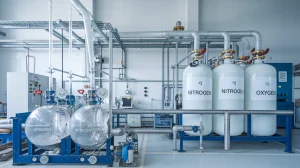Efficient and dependable onsite nitrogen technology is vital for agencies across industries. With advancements in technology, pressure swing adsorption nitrogen has emerged as a desired technique for generating nitrogen gasoline. This weblog will explore how PSA nitrogen turbines work, their benefits, and the elements influencing their adoption.
What Is Pressure Swing Adsorption Nitrogen Generation?
Pressure swing adsorption nitrogen generation is a device that separates nitrogen from atmospheric air using molecular sieves and selective adsorption. Air, generally composed of nitrogen and oxygen, is passed through a PSA device in which carbon molecular sieves (CMS) adsorb oxygen, allowing nitrogen to bypass as a purified gasoline. The PSA cycle alternates between adsorption and desorption, ensuring a non-prevent nitrogen supply.
How Does a PSA Gas Generator Work?
- Compression: Air is compressed and fed into the PSA generator.
- Adsorption: CMS beds entice oxygen molecules underneath strain.
- Desorption: Pressure is released, and the CMS regenerates by expelling trapped oxygen.
- Nitrogen Output: Purified nitrogen is delivered for commercial enterprise use.
Advantages of PSA Nitrogen Generators
1. Cost-Efficient Onsite Production
By generating nitrogen onsite, agencies can take away the ordinary prices associated with gasoline deliveries. PSA nitrogen generator prices are regularly offset through long-term financial savings on logistics and storage.
2. High Purity Levels
PSA era can produce nitrogen with a purity of up to 99.999%, appropriate for pharmaceuticals, meal packaging, and electronics production.
3. Energy Efficiency
Modern PSA nitrogen gas turbines are designed for minimum power intake, contributing to reduced operational costs and environmental impact.
4. Low Maintenance
PSA systems are renowned for their durability and simplicity of preservation, ensuring ordinary primary performance with minimal downtime.
5. Scalability and Customization
PSA nitrogen generators have several sizes and configurations, making them adaptable to the precise wishes of various industries.
Applications of PSA Nitrogen Gas Generators
- Food and Beverage Industry: Nitrogen preserves freshness in packaging and saves you from oxidation sooner or later in meal processing.
- Electronics Manufacturing: High-purity nitrogen is essential for developing inert surroundings in soldering and wafer production techniques.
- Pharmaceutical and Medical Fields: Nitrogen is applied for packaging medicines, sterilization, and cryopreservation.
- Metal Fabrication: Nitrogen is utilized in laser reducing and welding to beautify precision and decrease oxidation.
- Chemical Industry: PSA nitrogen generation helps inert gas blanketing and pressurization in chemical processing.
Key Factors to Consider When Choosing a PSA Gas Generator
- Capacity Requirements
Evaluate the nitrogen required to ensure the generator meets your operational desires.
- Purity Levels
Different packages call for numerous nitrogen purity tiers. Choose a generator that meets your employer’s requirements.
- Energy Consumption
Select an energy-green PSA nitrogen generator to lower walking charges.
- Maintenance and Reliability
Opt for a device with low preservation requirements and robust, regular, typical overall performance to lessen downtime.
- PSA Nitrogen Generator Price
While advance charges can also vary, consider the prolonged-term financial savings from the onsite nitrogen generation.
Frequently Asked Questions (FAQs)
Q.1 What Is a PSA Nitrogen Generator?
A PSA nitrogen generator is a device that separates nitrogen from air using stress swing adsorption technology. It ensures a non-prevent and fee-powerful supply of immoderate-purity nitrogen.
Q.2 How Much Does a PSA Nitrogen Generator Cost?
The rate is predicated on capacity, purity requirements, and further abilities. However, the onsite nitrogen era often ends in massive price economic savings over the years.
Q.3 Is a PSA Nitrogen Gas Generator Energy-Efficient?
Yes, PSA generators are designed to eat minimum electricity at the same time as turning in regular nitrogen output.
Q.4 What Industries Use PSA Nitrogen Generators?
Industries encompassing meals and beverages, prescription drugs, electronics, and metallic fabrication commonly use PSA nitrogen turbines.
Q.5 Can a PSA Generator Be Customized?
Yes, PSA structures are scalable and may be tailored to fulfill particular employer necessities.
Q.6 How Does Onsite Nitrogen Generation Benefit Businesses?
Onsite nitrogen generation reduces dependency on outdoor providers, lowers costs, and ensures ordinary nitrogen delivery.Ultimately, the stress swing adsorption nitrogen era is reworking how agencies get admission to nitrogen gas. By investing in the PSA era, industries can enhance overall performance, reduce expenses, and gain operational sustainability.



